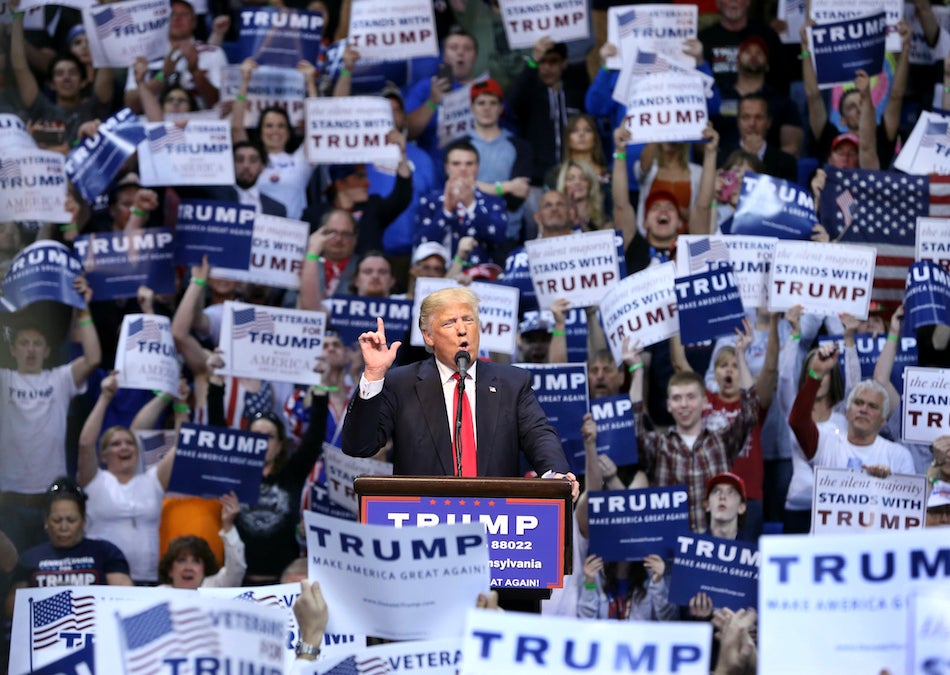Luzerne County voted for Trump, and has matched Pa.’s outcome since 1932

Donald Trump addresses a crowd of supporters in Wilkes Barre
For more than 80 years, Luzerne County’s presidential vote has matched the state’s outcome.
If last week’s election taught us anything, it’s that polling and predictions don’t always match up to the final outcome. By 2020, we may have resorted to reading signs in tea leaves or the stars to guess who the next president will be.
Or, should we just watch Luzerne County?
Luzerne, in Northeastern Pennsylvania, has voted for the candidate that took the state in every election since 1932. The last time Luzerne County disagreed with the rest of Pennsylvania was when Franklin Delano Roosevelt won the presidency and Luzerne County, but lost the Keystone State overall.
And Luzerne County doesn’t just pick the state’s winner. Recently, the county has even matched the percentage of votes earned by the winner, within a point.
In 2012, 52.08 percent of Pennsylvanians voted for President Barack Obama; In Luzerne County, 51.68 percent did. In 2008, 54.65 percent of Pennsylvanians voted for Obama, compared to 53.63 percent in Luzerne County. Lest you think Luzerne County is just good at predicting Obama wins, in 2004, note that the county voted 51.15 percent for Al Gore, whereas the state voted 50.96 percent.
This week, Luzerne County voted along with the rest of Pennsylvania, going red for the first time since 1988. But voters there overshot the mark a little. While the election was very close statewide, Luzerne County was a blowout. Trump earned 58.6 percent of the vote, compared to Clinton’s 38.5 percent.
A good gamble, but not a guarantee
Luzerne County is a bellwether in the sense that it tends to follow the trends of the state. If you could predict Luzerne County, you could in good faith, using historical data, bet on the outcome of the statewide vote.
But Thomas Baldino, professor of political science at Wilkes University, says that’s sort of a coincidence.
“I’m always hesitant to call it a bellwether county,” said Baldino. “You don’t need to win Luzerne County to win the state. We’re not setting any trends, really, or guiding the rest of the state in how to vote. We’re just really good followers.”
In some ways, Luzerne County looks like Pennsylvania: it’s a mix of urban and rural, skews older and has a growing Latino population. But compared to large population centers like Philadelphia, Allegheny County (where Pittsburgh is) and even neighboring Lackawanna County, Luzerne County is less diverse and growing more slowly, meaning that over time, it will be less reflective of the state’s voting population.
The harbinger of Trump
Luzerne County has long been a Democratic stronghold, with it’s white, working-class, union-affiliated population. The county hasn’t voted for a Republican president since 1988. But there have been some signs that the days of Democratic domination were coming to an end.
“Luzerne County now lines up much more closely with the demographic profile of Western Pennsylvania,” said Baldino. “Older, whiter voters living in areas that used to be supported by coal or steel, who have seen those good-paying jobs disappear and not come back. That area of the state has started to trend Republican over the last 15 years, and Luzerne County is starting to look more like that.”
And how.
In the primary, Trump had no greater success in Pennsylvania than Luzerne County, where he won 77 percent of the Republican vote. This election season, 5,643 Luzerne County Democrats switched to the Republican party, the largest shift in either direction from any county besides Philadelphia and Allegheny. U.S. Rep. Lou Barletta, a hard-line anti-immigration Republican who campaigned for Trump, was re-elected with 64 percent of the vote.
“These are people that aren’t happy and that want a change,” said Baldino. “They voted for Obama because he was promising hope and change, and they saw Clinton as the status quo, someone who gave paid speeches to companies that created the economic crisis. Donald Trump promised change, so they voted for the outsider.”
Red, white and blue
Generally, when you look at an electoral map of Pennsylvania, blue only shows up in counties with urban centers, like Philadelphia, Pittsburgh, Erie and those two counties in Northeastern Pennsylvania: Luzerne and Lackawanna.
But both Erie and Luzerne went red this election, and Baldino thinks Lackawanna might have as well, if Clinton hadn’t had family ties in the area.
This change doesn’t mean Pennsylvania will stay red permanently.
“It’s still more about how well you do in the southeastern corner of the state,” said Baldino. “Clinton did worse than Obama in Philadelphia and the suburbs, but if she’d won that area more decisively, she could have taken the state. That’s what I’m usually watching, not these smaller counties.”
While Luzerne County might not influence the outcome of the election the way Philadelphia does, it at least gets bragging rights for four more years.
No other Pennsylvania county has fallen on the winning side of history quite as often, or quite as reliably, as Luzerne.
WHYY is your source for fact-based, in-depth journalism and information. As a nonprofit organization, we rely on financial support from readers like you. Please give today.


